Related Research Articles

Garamond is a group of many serif typefaces, named for sixteenth-century Parisian engraver Claude Garamond, generally spelled as Garamont in his lifetime. Garamond-style typefaces are popular and particularly often used for book printing and body text.
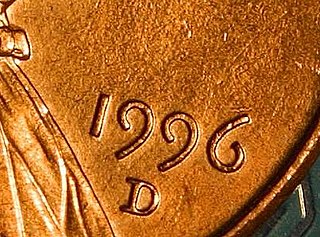
Text figures are numerals designed with varying heights in a fashion that resembles a typical line of running text, hence the name. They are contrasted with lining figures, which are the same height as upper-case letters. Georgia is an example of a popular typeface that employs text figures by default.

Punchcutting is a craft used in traditional typography to cut letter punches in steel as the first stage of making metal type. Steel punches in the shape of the letter would be used to stamp matrices into copper, which were locked into a mould shape to cast type. Cutting punches and casting type was the first step of traditional typesetting. The cutting of letter punches was a highly skilled craft requiring much patience and practice. Often the designer of the type would not be personally involved in the cutting.

Claude Garamont, known commonly as Claude Garamond, was a French type designer, publisher and punch-cutter based in Paris. Garamond worked as an engraver of punches, the masters used to stamp matrices, the moulds used to cast metal type. He worked in the tradition now called old-style serif design, which produced letters with a relatively organic structure resembling handwriting with a pen but with a slightly more structured and upright design. Considered one of the leading type designers of all time, he is recognised to this day for the elegance of his typefaces. Many old-style serif typefaces are collectively known as Garamond, named after the designer.
The Greek Font Society is a non-profit organization in Greece, founded in 1992, devoted to improving the standard of Greek digital typography.
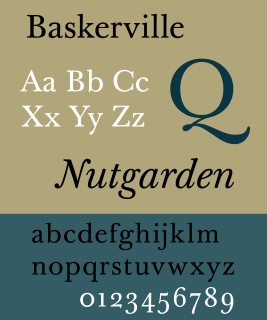
Baskerville is a serif typeface designed in the 1750s by John Baskerville (1706–1775) in Birmingham, England, and cut into metal by punchcutter John Handy. Baskerville is classified as a transitional typeface, intended as a refinement of what are now called old-style typefaces of the period, especially those of his most eminent contemporary, William Caslon.
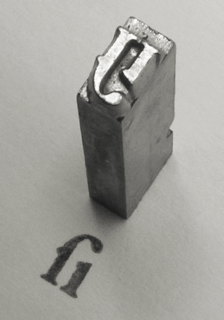
Modern typographers view typography as a craft with a very long history tracing its origins back to the first punches and dies used to make seals and coinage currency in ancient times. The basic elements of typography are at least as old as civilization and the earliest writing systems—a series of key developments that were eventually drawn together into one systematic craft. While woodblock printing and movable type had precedents in East Asia, typography in the Western world developed after the invention of the printing press by Johannes Gutenberg in the mid-15th century. The initial spread of printing throughout Germany and Italy led to the enduring legacy and continued use of blackletter, Roman and italic types.

Sabon is an old-style serif typeface designed by the German-born typographer and designer Jan Tschichold (1902–1974) in the period 1964–1967. It was released jointly by the Linotype, Monotype, and Stempel type foundries in 1967. The design of the roman is based on types by Claude Garamond, particularly a specimen printed by the Frankfurt printer Konrad Berner. Berner had married the widow of a fellow printer Jacques Sabon, the source of the face's name, who had bought some of Garamond's type after his death. The italics are based on types designed by a contemporary of Garamond's, Robert Granjon. It is effectively a Garamond revival, though a different name was chosen as many other modern typefaces already carry this name.
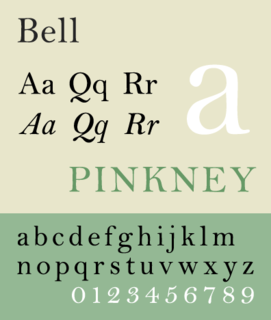
Bell is the name given to a serif typeface designed and cut in 1788 by the punchcutter Richard Austin for the British Letter Foundry, operated by publisher John Bell, and revived several times since.

Bulmer is the name given to a serif typeface originally designed by punchcutter William Martin around 1790 for the Shakespeare Press, run by William Bulmer (1757–1830). The types were used for printing the Boydell Shakespeare folio edition.

Script typefaces are based upon the varied and often fluid stroke created by handwriting. They are generally used for display or trade printing, rather than for extended body text in the Latin alphabet. Some Greek alphabet typefaces, especially historically, have been a closer simulation of handwriting.
Richard Austin (1756–1832) was an English punchcutter. He was the original cutter of the typefaces now known as Bell, Scotch Roman, and Porson. Born in London 4 August 1756 and christened at St Luke's Old Street, he studied seal, die and copper-plate engraving as an apprentice to John Phillips near Finsbury Square. He married Phillips' daughter Sarah and set up on his own about 1786. He was hired by John Bell's British Letter Foundry in 1788 as a punch-cutter, to imitate Didot's 1782 types "de la troisième manière," cut by Pierre Vafflard to F-A Didot's designs. Bell sold his interest in the foundry to S & C Stephenson. When the foundry closed in 1797, Austin brought in his own punches and sold strikes to Fry & Steele, Figgins, and Caslon. Strikes were even sold in North America. Austin cut Greek types for Cambridge University Press in 1806–8, following designs provided by the famous master Richard Porson. He probably also cut the Sarcophagus Greek that preceded it. Austin then provided strikes to William Miller's foundry in Edinburgh & Alexander Wilson's Sons' foundry in Glasgow, creating the types now known as Scotch, before founding his own Imperial Letter Foundry in London in 1815, with his son George. The first Miller Specimen of 1809 is now lost. Wilson's earliest specimen showing the improved types is dated 1812. Richard Austin died circa 20 August 1832, leaving the foundry to his son George, whom many credited with the innovations in type designs manifest in the Scotch types. Austin's other sons were John Phillips Austin, a music engraver, and Richard Turner Austin (1781-1842), a painter and commercial wood engraver.

Les grecs du roi are a celebrated and influential Greek typeface cut by the French punchcutter Claude Garamond between 1541 and 1550. Arthur Tilley calls the books printed from them "among the most finished specimens of typography that exist".
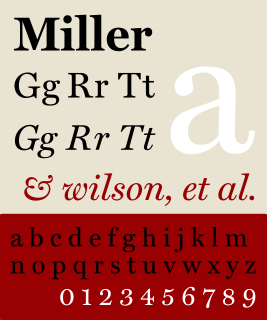
Miller is a serif typeface, released in 1997 by the Font Bureau, a U.S.-based digital type foundry. It was designed by Matthew Carter and is of the 'transitional' style from around 1800, based on the "Scotch Roman" type which originates from types sold by Scottish type foundries that later became popular in the United States. It is named for William Miller, founder of the long-lasting Miller & Richard type foundry of Edinburgh.

Vincent Figgins was a British typefounder based in London, who cast and sold metal type for printing. After an apprenticeship with typefounder Joseph Jackson, he established his own type foundry in 1792. His company was extremely successful and, with its range of modern serif faces and display typefaces, had a strong influence on the styles of British printing in the nineteenth century.

Joan Michaël Fleischman, was an 18th-century German-Dutch typographer and punchcutter.
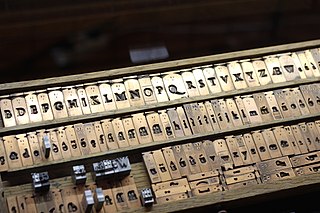
Jean Jannon was a French Protestant printer, type designer, punchcutter and typefounder active in Sedan in the seventeenth century. He was a reasonably prolific printer by contemporary standards, printing several hundred books.

Christoffel van Dijck was a German-born Dutch punchcutter and typefounder, who engraved and cast metal type. He is believed to have been influential in the development of Amsterdam as a centre of printing in the Netherlands.
Pierre Haultin was a French printer, publisher, punchcutter and typefounder.

The Caslon type foundry was a type foundry in London which cast and sold metal type. It was founded by the punchcutter and typefounder William Caslon I, probably in 1720. For most of its history it was based at Chiswell Street, Islington, was the oldest type foundry in London, and the most prestigious.
References
- Bowman, J. H. (1992). Greek Printing Types in Britain in the Nineteenth Century: A Catalogue. Oxford: Oxford Bibliographical Society.
- Bringhurst, Robert (2004). The Elements of Typographic Style. Point Roberts, WA: Hartley & Marks.
- Dictionary of National Biography (1917). Vol. XVI. London: Oxford University Press.
- Sandys, Sir John Edwin (1998 [1903-1908]). A History of Classical Scholarship. Vol. II . Bristol: Thoemmes Press.
- Watson, John Selby (1861). A Life of Richard Porson, M. A.. London: Longman, Green, Longman, and Roberts.